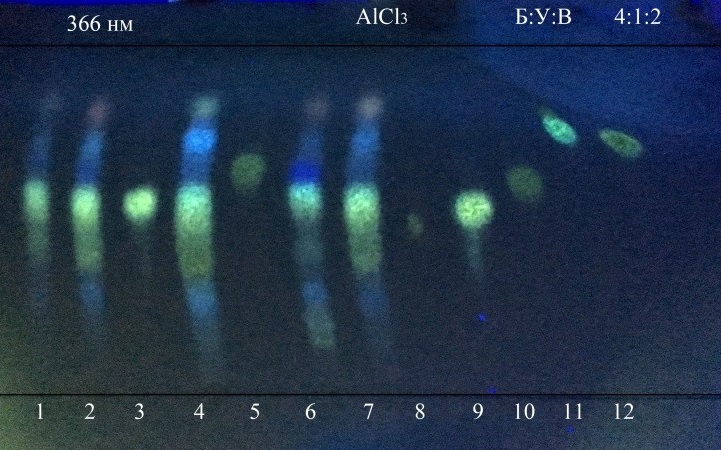JUSTIFICATION OF THE METHODS FOR THE QUALITATIVE AND QUANTITATIVE DETERMINATION OF FLA-VONOIDS IN THE GRASS OF SPECIES OF THE GENUS MONARDA
UDC 615.322:547.972+543.544
Abstract
The herb of plants of the genus Monarda L. is most often known for its essential oil the main components of which are thymol and carvacrol. However flavonoids contained in the raw materials of this plant are of great interest. The literature reports on the presence in the herb of species of the genus Monarda L. quercetin, luteolin, rutin, hesperidin, naringinin; howeve, these data are contradictory. It is known that when determining the content of the amount of flavonoids, recalculation is carried out in different cases for luteolin or rutin, which have different spectrum characteristics. This paper discusses the results of a comparative study of the flavonoid composition of some species of the genus Monarda: Monarda fistulosa L., Monarda didyma L., Monarda bradburiana L. Back., Monarda citriodora L., Monarda × medioides W.H.Duncan as a promising source of biologically active compounds. As a result of a comparative chromatographic study, the presence of flavonoids was detected upon detection at a wavelength of 366 nm and after treatment with an alcohol solution of aluminum chloride. In all treatments, the presence of cynaroside, rutin, quercetin, luteolin is not confirmed. Using column chromatography on silica gel L 40/100, from the herb of Monarda fistulosa the flavonoid substances for the first time were isolated – isorhoifolin (7-O-rutinoside of apigenin) and linarin (7-O-rutinoside of acacetin), which have n-butanol–acetic acid–water (4 : 1 : 2) in the solvent system Rf values are about 0.5 and 0.6, respectively, and also dimydin (7-O-rutinoside of sakuranetin). It was determined that in all UV spectra of extracts from herb of studied species of the genus Monarda of the species, a bathochromic shift of the long-wavelength band is observed in the presence of 3% alcoholic solution aluminum chloride, which confirms the presence of flavonoids. Under the conditions of differential spectrophotometry, an absorption maximum is observed in the region of 392–396 nm, which indicates the feasibility of using isorhoifolin in the analysis technique with an absorption maximum at a wavelength of 394 nm. As a result of the work a method of quantitative determination of the amount of flavonoids of the herb of the Monarda has been developed. The optimal parameters were determined: 60% ethyl alcohol, the ratio of "raw material to extractant" – 1 : 50, extraction time – 60 minutes, analytical wavelength at 394 nm. It was determined that the content of the total of flavonoids calculated on isorhoifolin in all samples studied varies from 4.53% to 8.73%.
Downloads
Metrics
References
Anishchenko I.Ye. Vestnik Orenburgskogo gosudarstvennogo universiteta, 2009, no. 6, pp. 35–38. (in Russ.).
Mashchenko Z.Ye. Fitokhimicheskoye issledovaniye i standartizatsiya timolsoderzhashchikh rasteniy semeystva Yasnotkovykh: dis. … kand. farm. nauk. [Phytochemical research and standardization of thymol-containing plants of the Yasnotkov family: dis. ... cand. Pharm. of sciences]. Perm, 2004, pp. 119. (in Russ.).
Linnaei C. Species plantarum, exhibentes plantas rite cognitas, ad genera relatas, cum differentiis specificis, nominibus trivialibus, synonymis selectis, locis natalibus, secundum systema sexuale digestas. Holmiae: L. Salvius, 1753, vol. 1, 560 p. DOI: 10.5962/bhl.title.11179.
Kharchenko V.A., Bespal'ko L.V., Gins V.K., Gins M.S., Baykov A.A. Ovoshchi Rossii, 2015, no. 1(26), pp. 31–35. (in Russ.).
Anishchenko Ye.I., Pupykina K.A., Krasyuk Ye.V., Zhigunov O.Yu. Izvestiya Ufimskogo nauchnogo tsentra RAN, 2017, no. 3, pp. 71–76. (in Russ.).
Logvinenko L.A., Khlypenko L.A., Marko N.V. Farmatsiya i farmakologiya, 2016, vol. 4, no. 4, pp. 34–47. DOI: 10.19163/2307-9266-2016-4-4-34-47. (in Russ.).
Korchashkina N.V. Biologicheskiye osobennosti rosta i razvitiya vidov roda Monarda (Monarda L.) v usloviyakh nechernozemnoy zony Rossiyskoy Federatsii: avtoref. dis. … kand. biol. nauk. [Biological features of the growth and development of species of the genus Monarda (Monarda L.) in the non-chernozem zone of the Russian Federation: au-thor. dis. ... cand. biological sciences]. M., 2009, 23 p. (in Russ.).
Krasyuk Ye.V., Pupykina K.A. Yevraziyskiy Soyuz Uchenykh, 2015, no. 3(12), pp. 154–155. (in Russ.).
Krasyuk Ye.V., Pupykina K.A., Anishchenko I. Ye. Bashkirskiy khimicheskiy zhurnal. 2015, vol. 22, no. 3, pp. 79–83.
Kurkin V.A. Farmakognoziya: Uchebnik dlya studentov farmatsevticheskikh vuzov (fakul'tetov). [Pharmacognosy: Textbook for students of pharmaceutical universities (faculties)]. Samara, 2016, 1279 p. (in Russ.).
Oparin R.V., Pokrovskiy L.M., Vysochina G.I., Tkachev A.V. Khimiya Rastitel'nogo Syr'ya, 2000, no. 3, pp. 19–24. (in Russ.).
Dmitriyeva V.L., Dmitriyev L.B. Izvestiya TSKHA, 2011, no. 3, pp. 106–119. (in Russ.).
Fedotov S.V. Sbornik nauchnykh trudov Gosudarstvennogo Nikitskogo botanicheskogo sada, 2015, no. 141, pp. 131–147. (in Russ.).
Khlypenko L.A., Logvinenko L.A., Shevchuk O.M., Fes'kov S.A., Marko N.V. Sbornik nauchnykh trudov Gosudar-stvennogo Nikitskogo botanicheskogo sada, 2015, no. 141, pp. 110–117. (in Russ.).
Naumenko Ye.N., Zhilyakova Ye.T., Novikov O.O., Krichkovskaya L.V., Timoshenko Ye.Yu., Stupakov A.G. Nauchnyye vedomosti Belgorodskogo gosudarstvennogo universiteta. Seriya: Yestestvennyye nauki, 2012, no. 21–1(140), pp. 154–158. (in Russ.).
Zhilyakova Ye.T., Novikov O.O., Naumenko Ye.N., Krichkovskaya L.V., Polukhina T.S., Timoshenko Ye.Yu., Novikova M.Yu., Litvinov S.A. Kubanskiy nauchnyy meditsinskiy vestnik, 2010, no. 8(122), pp. 68–72. (in Russ.).
Zaslavskaya A.A., Dmitruk V.I., Zlobinets A.S. Aktual'naya infektologiya, 2017, vol. 5, no. 2, pp. 101–111. (in Russ.).
Nikolayevskiy V.V. Aromaterapiya: Spravochnik. [Aromatherapy: A Guide]. Moscow, 2000, 336 p. (in Russ.).
Zhilyakova Ye.T., Novikov O.O., Naumenko Ye.N., Kuz'micheva O.A., Bocharova K.A., Titareva L.V. Nauchnyye ve-domosti. Seriya Meditsina. Farmatsiya, 2013, no. 25(168), pp. 198–201. (in Russ.).
Krasyuk Ye.V., Makarova N.N., Petrova I.V., Pupykina K.A., Valeyeva L.A. Meditsinskiy vestnik Bashkortostana, 2015, vol. 10, no. 5(59), pp. 67–70. (in Russ.).
Bespal'ko L.V., Baykov A.A., Gins M.S., Gins V.K. Materialy XI mezhdunarodnogo simpoziuma «Novyye i netraditsionnyye rasteniya i perspektivy ikh ispol'zovaniya». [Materials of the XI international symposium "New and unconventional plants and prospects for their use"]. Pushchino, 2015, pp. 114–118. (in Russ.).
Bespal'ko L.V., Baykov A.A., Gins V.K., Kharchenko V.A., Ushakova I.T. Novyye i netraditsionnyye rasteniya i perspektivy ikh ispol'zovaniya. 2017, pp. 88–95. (in Russ.).
Bogdanova M.N., Fes'kov S.A. Aktual'nyye problemy eksperimental'noy i klinicheskoy meditsiny. [Actual problems of experimental and clinical medicine]. Volgograd, 2017, pp. 787. (in Russ.).
Sargsyan Ye.E., Nikitina A.S., Stepanyuk S.N. Belikovskiye chteniya. [Belikov readings]. Pyatigorsk, 2015, pp. 128–129. (in Russ.).
Krasyuk Ye.V., Pupykina K.A. Meditsinskiy vestnik Bashkortostana, 2016, vol. 11, no. 5(65), pp. 73–77. (in Russ.).
Shagaliyeva N.R. Aspirantskiy vestnik Povolzh'ya, 2011, no. 5–6, pp. 276–279. (in Russ.).
Wagner H., Hörhammer L., Aurnhammer G., Farkas L. Tetrahedron Letters, 1967, vol. 8, no. 19, pp. 1837–1839.

Copyright (c) 2020 сhemistry of plant raw material

This work is licensed under a Creative Commons Attribution 4.0 International License.

This work is licensed under a Creative Commons Attribution 4.0 International License.
The authors, which are published in this journal, agree to the following conditions:
1. Authors retain the copyright to the work and transfer to the journal the right of the first publication along with the work, at the same time licensing it under the terms of the Creative Commons Attribution License, which allows others to distribute this work with the obligatory indication of the authorship of this work and a link to the original publication in this journal .
2. The authors retain the right to enter into separate, additional contractual agreements for the non-exclusive distribution of the version of the work published by this journal (for example, to place it in the university depository or to publish it in a book), with reference to the original publication in this journal.
3. Authors are allowed to post their work on the Internet (for example, in a university repository or on their personal website) before and during the review process of this journal, as this may lead to a productive discussion, as well as more links to this published work.











